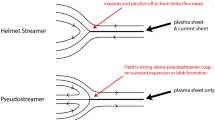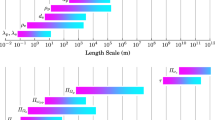Abstract
The behaviour of continuous pulsations pc 2–5 observed on the ground has been known for some time. They seldom occur at night, their amplitudes generally increase towards the auroral zones and the sense of rotation of their polarisation often agrees with surface waves on the magnetopause. Recently ULF sonagrams for middle latitudes have shown systematic behaviour and dominant periods. Theoretical study of normal modes for symmetrical models is also well established. If the wave depends on longitude φ like eimφ, modes with large m are quasi-transverse and these are likely to be excited and will be emphasised.
The Kelvin-Helmholtz instability has recently been studied in a general formulation. For given fields and plasma properties on both sides of the boundary, a plot of critical wind speed against the direction of the wave fronts shows a cusp, meaning that for most directions of the wind the onset of instability will correspond to the cusp and the nature of the waves can be predicted from this. Almost circularly polarised waves are predicted confirming an earlier heuristic suggestion.
Magnetic data from Explorer 33 shows rather irregular disturbance near the magnetopause, but an integration designed to show the sense of rotation of the polarisation shows clear agreement. The disturbance outside the magnetopause also shows the predicted polarisation, indicating that a substantial part of it must be due to surface waves, whereas previously it was believed to be the turbulence of the magnetosheath.
Bounce resonance has also been invoked to excite ULF waves, particularly those observed at the geostationary orbit, which may also correspond to pg at the ground. They are remarkably regular and quite strictly transverse, suggesting large m. Energetic particles may then see a higher frequency as a result of their drift. A simple picture of the exchange of energy is obtained using a frame rotating with the wave and it is seen that the wave can be driven by a spatial gradient in the energetic particles. The most important mechanism is due to the tilting of the field lines and the growth rate can be large. The reflection by the ionosphere requires further study.
Similar content being viewed by others
References
Anderson, K. A., Binsack, J. H., and Fairfield, D. H.: 1968, J. Geophys. Res. 73, 2371.
Annexstad, J. O. and Wilson, C. R.: 1968, J. Geophys. Res. 73, 1805.
Atkinson, G. and Watanabe, T.: 1966, Earth Planet. Sci. Lett. 1, 89.
Cahill, L. J., Jr. and Amazeen, P. G.: 1963, J. Geophys. Res. 68, 1835.
Campbell, W. H.: 1968, in Physics of Geomagnetic Phenomena (ed. by S. Matsushita and W. H. Campbell), Academic Press, New York, p. 821.
Cummings, W. D. and Coleman, P. J., Jr.: 1968, J. Geophys. Res. 73, 5699.
Cummings, W. D., O'Sullivan, R. J., and Coleman, P. J., Jr.: 1969, J. Geophys. Res. 74, 778.
Dungey, J. W.: 1963, in Proc. of the International Conference on the Ionosphere, Institute of Physics and the Physical Society, London, p. 231.
Dungey, J. W.: 1965, Space Sci. Rev. 4, 199.
Dungey, J. W.: 1968, in Physics of Geomagnetic Phenomena (ed. by S. Matsushita and W. H. Campbell), Academic Press, New York, p. 913.
Fairfield, D. H. and Ness, N. F.: 1967, J. Geophys. Res. 72, 2379.
Greenstadt, E. W., Inonye, G. T., Green, I. M., and Judge, D. L.; 1967, J. Geophys. Res. 72, 3855.
Herron, T. J.: 1966, J. Geophys. Res. 71, 871.
Hirasawa, T., Oguti, T., and Nagata, T.: 1965, Rept. Ionosph. Space Res. Japan 19, 452.
Hruska, A.: 1968, Planet. Space Sci. 16, 1305.
Hyde, R. S.: 1967, Univ. of New Hampshire Report, UNH-67-6.
Jacobs, J. A. and Sinno, K.: 1960, J. Geophys. Res. 65, 107.
Judge, D. L. and Coleman, P. J., Jr.: 1962, J. Geophys. Res. 67, 5071.
Kahalas, S. L.: 1969, Planet. Space Sci. 17, 1281.
Kato, Y. and Utsumi, T.: 1964, Rept. Ionosph. Space Res. Japan 18, 214.
Kitamura, T.: 1963, Sept. Ionosph. Space Res. Japan 17, 67.
Kaufmann, R. L. and Konradi, A.: 1968, Goddard Space Flight Center Report, X-612-448.
Lezniak, T. W. and Winkler, J. R.: 1968, J. Geophys. Res. 73, 5733.
Mainstone, J. S.: 1966, preprint.
Mainstone, J. S.: 1967, Nature 215, 1048.
Mainstone, J. S.: 1968, Presented at Micropulsation Symposium, Newcastle, N.S.W., Australia.
McNicol, R. W. E. and Mainstone, J. S.: 1963, Austral. J. Phys. 16, 507.
Nagata, T., Kokubun, S., and Iijima, T.: 1963, J. Geophys. Res. 68, 4621.
Patel, V. L.: 1965, Planet. Space Sci. 13, 485.
Patel, V. L.: 1966, Earth Planet. Sci. Lett. 1, 282.
Patel, V. L. and Cahill, L. J., Jr.: 1964, Phys. Rev. Lett. 12, 213.
Patel, V. L., Cahill, L. J., Jr. and Dessler, A. J.: 1967, J. Geophys. Res. 72, 426.
Radoski, H. R. and McClay, J. F.: 1967, J. Geophys. Res. 72, 4899.
Sonett, C. P.: 1963, J. Geophys. Res. 68, 6371.
Southwood, D. J.: 1968, Planet. Space Sci. 16, 587.
Southwood, D. J., Dungey, J. W., and Etherington, R. J.: 1969, Planet. Space Sci. 17, 349.
Sugiura, M. and Wilson, C. R.: 1964, J. Geophys. Res. 69, 1211.
Troitskaya, V. A.: 1967, in Solar Terrestrial Physics, Academic Press, London, p. 213.
Van-Chi, Fam, Yanowskiy, B. M., Kovtun, A. A., Raspopov, O. M., Troitskaya, V. A., and Schlich, R.: 1968, Geomag. and Aeron. 8, 94. (In English).
Voelker, H.: 1968, in Birkeland Symposium on Aurora and Magnetic Storms (ed. by A. Egeland and J. Holtet), Centre National de la Recherche Scientifique, p. 257.
Author information
Authors and Affiliations
Rights and permissions
About this article
Cite this article
Dungey, J.W., Southwood, D.J. Ultra low frequency waves in the magnetosphere. Space Sci Rev 10, 672–688 (1970). https://doi.org/10.1007/BF00171551
Received:
Issue Date:
DOI: https://doi.org/10.1007/BF00171551




